- Regulatory Status
- RUO
- Other Names
- SIS-delta, T-cell specific protein p288, Regulated on Activation Normal T-expressed and Secreted (RANTES), Wmall inducible cytokine A5
- Ave. Rating
- Submit a Review
- Product Citations
- publications
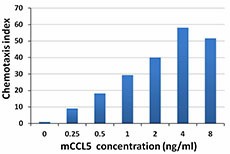
-

Baf3-hCCR5 transfectants chemoattracted by mouse CCL5.
CCL5 is a CC chemokine that directs the migration of leukocytes in immune and inflammatory responses. Increased CCL5 expression has been associated with a wide range of inflammatory disorders and pathologies. It has been shown that CCL5 is highly expressed by breast tumor cells at primary tumor sites and is strongly associated with the progression of breast cancer. CCL5 may contribute to tumor progression by recruiting monocytes into tumor sites, and CCL5 can also stimulate the release of MMP, thereby promoting tumor cell migration. Some studies also show that CCL5 has pro-angiogenesis effects in vivo and in vitro. CCL5 oligomerization and binding to GAGs can induce angiogenic effects through its receptor CCR1 and CCR5. CCL5 is expressed in the early stages of many viral infections. It has been shown that CCL5 is protective against many viruses including influenza, RSV, HCMV, HCV, and HIV. CCL5 can inhibit HIV infection by competing with the virus for CCR5 binding. CCL5 also has been implicated in the development of asthma, artherosclerosis, and fibrosis.
Product DetailsProduct Details
- Source
- Mouse CCL5, amino acids Ser24 - Ser91 (Accession# Q5XZF2), was expressed in E. coli.
- Molecular Mass
- The 68 amino acid recombinant protein has a predicted molecular mass of approximately 7.8 kD. The DTT-reduced protein migrates at approximately 10 kD and non-reduced protein migrates at approximately 11 kD by SDS-PAGE. The predicted N-terminal amino acid is Serine.
- Purity
- >97%, as determined by Coomassie stained SDS-PAGE.
- Formulation
- 0.22 µm filtered protein solution is 0.1 M Glycine, 0.15 M NaCl buffer, pH 3.0.
- Endotoxin Level
- Less than 0.01 ng per µg cytokine as determined by the LAL method.
- Concentration
- 10 and 25 µg sizes are bottled at 200 µg/mL. 100 µg size and larger sizes are lot-specific and bottled at the concentration indicated on the vial. To obtain lot-specific concentration and expiration, please enter the lot number in our Certificate of Analysis online tool.
- Storage & Handling
- Unopened vial can be stored between 2°C and 8°C for up to 2 weeks, at -20°C for up to six months, or at -70°C or colder until the expiration date. For maximum results, quick spin vial prior to opening. The protein can be aliquoted and stored at -20°C or colder. Stock solutions can also be prepared at 50 - 100 µg/mL in appropriate sterile buffer, carrier protein such as 0.2 - 1% BSA or HSA can be added when preparing the stock solution. Aliquots can be stored between 2°C and 8°C for up to one week and stored at -20°C or colder for up to 3 months. Avoid repeated freeze/thaw cycles.
- Activity
- Bioactivity was measured by its ability to chemoattract Baf3-hCCR5 cells in a dose dependent manner.
- Application
-
Bioassay
- Application Notes
-
BioLegend carrier-free recombinant proteins provided in liquid format are shipped on blue-ice. Our comparison testing data indicates that when handled and stored as recommended, the liquid format has equal or better stability and shelf-life compared to commercially available lyophilized proteins after reconstitution. Our liquid proteins are verified in-house to maintain activity after shipping on blue ice and are backed by our 100% satisfaction guarantee. If you have any concerns, contact us at tech@biolegend.com.
- Product Citations
-
Antigen Details
- Structure
- Chemokine
- Distribution
-
CCL5 is secreted by lymphocytes, macrophages, eosinophils, platelets, and fibroblasts. CCL5 is expressed by hepatocytes, sinusoidal endothelial cells and biliary epithelium during chronic hepatitis C.
- Function
- CCL5 can promote IL-2 and IL-5 expression in human T cells, and the expression of IL-6 and IL-8 in fibroblasts from patients with RA. CCL5 modulates LPS-induced IL-6 and TNFα in peripheral blood monocytes; this modulation occurs through the induction of IL-10 by CCL5.
- Interaction
- CCL5 is a chemoattractant for memory and activated T cells, monocytes, dendritic cells, eosinophils, NK cells, mast cells, and basophils.
- Ligand/Receptor
- CCL5 binds to CCR1, CCR3, and CCR5 receptors. CCL5 also binds to CCR9 but does not induce calcium flux, and therefore there is no chemotactic response.
- Cell Type
- Dendritic cells, Tregs
- Biology Area
- Cell Biology, Immunology, Innate Immunity, Neuroinflammation, Neuroscience
- Molecular Family
- Cytokines/Chemokines
- Antigen References
-
1. Schall, et al. 1990. Nature 347:669.
2. Cocchi F, et al. 1995. Science 270:1811.
3. Shahrara S, et al. 2006. J. Immunol. 177:5077.
4. Larrubia JR, et al. 2008. World J. Gastroenterol. 14:7149.
5. Gleissner CA, et al. 2008. Arterioscler. Thromb. Vasc. Biol. 28:1920.
6. Marques RE, et al. 2013. Expert Opin. Ther. Targets 17:1439. - Gene ID
- 20304 View all products for this Gene ID
- UniProt
- View information about CCL5 on UniProt.org
Related FAQs
- Why choose BioLegend recombinant proteins?
-
• Each lot of product is quality-tested for bioactivity as indicated on the data sheet.
• Greater than 95% Purity or higher, tested on every lot of product.
• 100% Satisfaction Guarantee for quality performance, stability, and consistency.
• Ready-to-use liquid format saves time and reduces challenges associated with reconstitution.
• Bulk and customization available. Contact us.
• Learn more about our Recombinant Proteins. - How does the activity of your recombinant proteins compare to competitors?
-
We quality control each and every lot of recombinant protein. Not only do we check its bioactivity, but we also compare it against other commercially available recombinant proteins. We make sure each recombinant protein’s activity is at least as good as or better than the competition’s. In order to provide you with the best possible product, we ensure that our testing process is rigorous and thorough. If you’re curious and eager to make the switch to BioLegend recombinants, contact your sales representative today!
- What is the specific activity or ED50 of my recombinant protein?
-
The specific activity range of the protein is indicated on the product datasheets. Because the exact activity values on a per unit basis can largely fluctuate depending on a number of factors, including the nature of the assay, cell density, age of cells/passage number, culture media used, and end user technique, the specific activity is best defined as a range and we guarantee the specific activity of all our lots will be within the range indicated on the datasheet. Please note this only applies to recombinants labeled for use in bioassays. ELISA standard recombinant proteins are not recommended for bioassay usage as they are not tested for these applications.
- Have your recombinants been tested for stability?
-
Our testing shows that the recombinant proteins are able to withstand room temperature for a week without losing activity. In addition the recombinant proteins were also found to withstand four cycles of freeze and thaw without losing activity.
- Does specific activity of a recombinant protein vary between lots?
-
Specific activity will vary for each lot and for the type of experiment that is done to validate it, but all passed lots will have activity within the established ED50 range for the product and we guarantee that our products will have lot-to-lot consistency. Please conduct an experiment-specific validation to find the optimal ED50 for your system.
- How do you convert activity as an ED50 in ng/ml to a specific activity in Units/mg?
-
Use formula Specific activity (Units/mg) = 10^6/ ED50 (ng/mL)
 Login / Register
Login / Register 







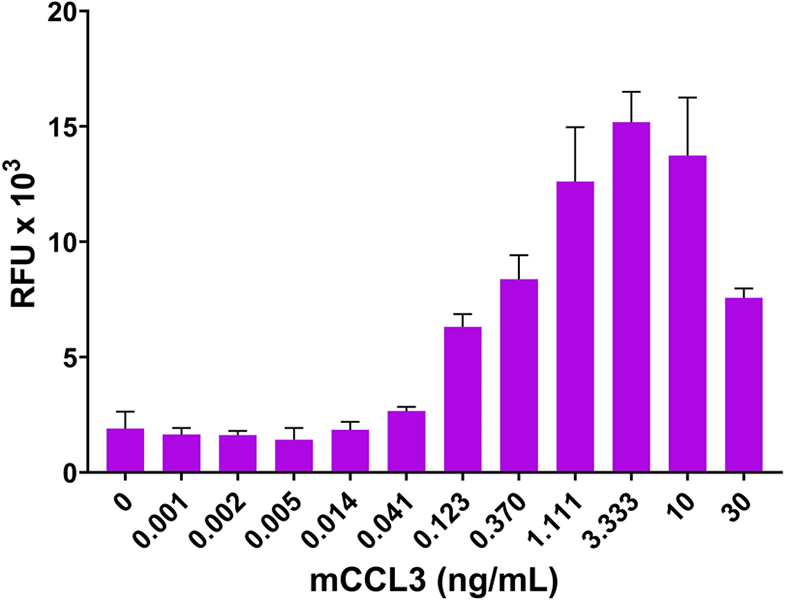
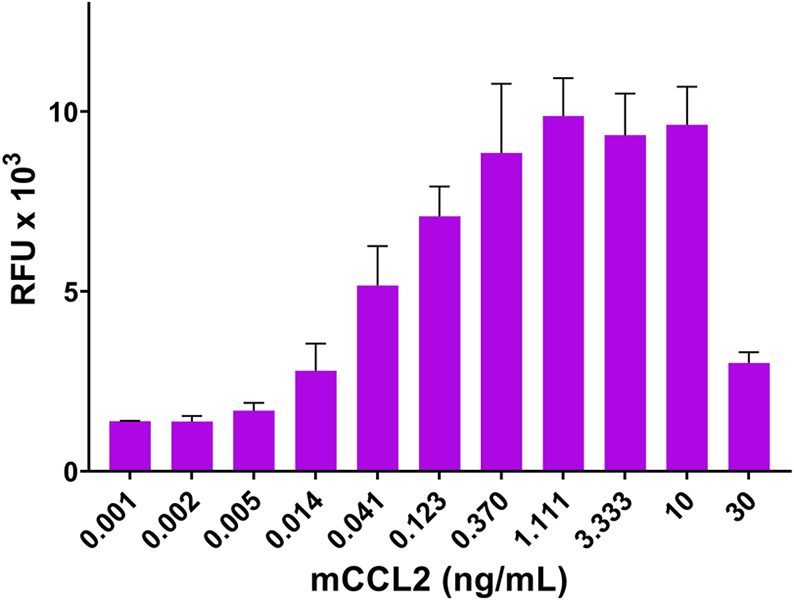
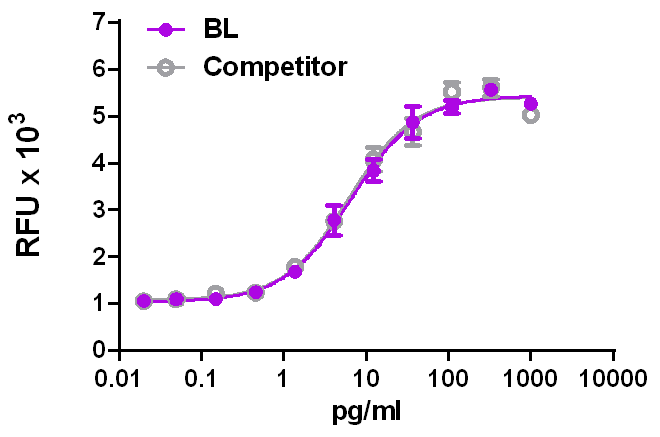
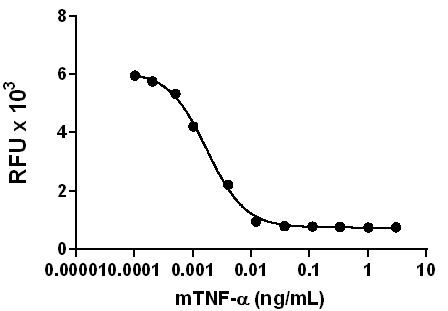



Follow Us